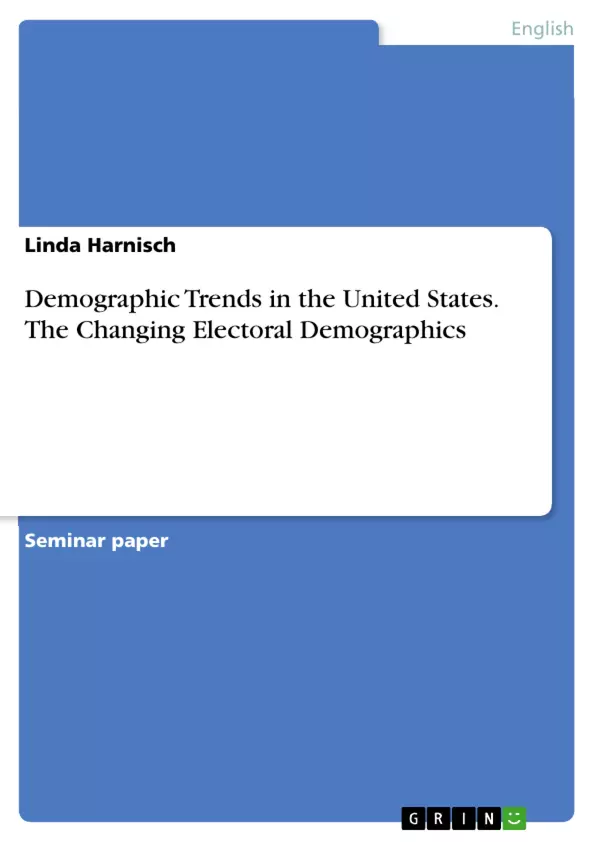Following the 2012 presidential election in the United States, the demographic make up of the U.S. electorate has been the focal point of discussions and analysis in the national, even in the international media. The week following the elections, it became clear that November 6, 2012 marked the date that demographic change had caught up with America, or rather with the Republican Party. Suddenly it became very obvious that the American electorate has undergone significant demographic changes that will continue in the future and have fundamental impacts on governing and policy-making. In this paper, I want to examine which trends will change American electoral demographics or have changed them already. What do certain demographic shifts mean for the electorate of the 21st century?
Evaluating presidential election exit polls, data by the U.S. Census Bureau as well as research reports by e.g. the Pew Research Center and media coverage about the 2012 elections, my thesis in this paper is as follows: I am arguing that there is an emerging new 21st century electorate in respect to young voters, ethnic diversity and minority groups, certain subgroups of the female population and transformations in the U.S. workforce. I have narrowed my analysis down to these factors, but I want to point out that other factors such as geographical shifts or changes in religious views could also play a decisive role in the changing 21st century electorate of the U.S.
Most of the U.S. population is not “white” as it used to be. The U.S. population is growing more diverse every year and demographers argue for the States to become a so-called “majority- minority” nation over the next decades. Hence, chapter one highlights population diversification and what it means for the changing electorate demographics. In chapter two, I am going to focus on generational cohorts and demographic change. Hereby the “millennial generation” and their part in the emerging new electorate will be at the centre. In the 2012 presidential elections women voters have been described as the key to elections. In this regard, chapter three will deal with demographic changes within the American female population. Especially with the growing influence of certain growing subgroups of women such as unmarried- and well-educated women.
Inhaltsverzeichnis (Table of Contents)
- Introduction
- Population Diversification - Minority Voters
- On a Way to a "Majority-Minority" Nation
- Declining Non-Hispanic White Population
- Minority Groups, Democrat's Biggest Constituencies are Growing
- Millennial Generation
- Rising Importance of Millennial Voters
- Unsteady Allegiance to the Democratic Party
- Trends in the Female Population
- Unmarried Women
- Well-Educated Women
- Transformations in the Workforce
- Professionals As a Growing Demographic Group
- Professionals, a Key Demographic Voting Bloc
- Conclusion
Zielsetzung und Themenschwerpunkte (Objectives and Key Themes)
This paper examines the demographic trends that have influenced and will continue to influence American electoral demographics. It analyzes how shifts in the population, particularly the growing diversity, the rise of millennial voters, changes in the female population, and transformations in the workforce, are impacting the electorate of the 21st century.
- The emergence of a new 21st century electorate
- Population diversification and the growing importance of minority voters
- The role of the millennial generation in shaping the electorate
- Demographic shifts within the American female population
- The impact of transformations in the U.S. workforce on voting patterns
Zusammenfassung der Kapitel (Chapter Summaries)
The introduction establishes the significance of demographic changes in the U.S. electorate following the 2012 presidential election. It highlights the shift towards a more diverse population and the implications for governing and policy-making.
Chapter one focuses on population diversification and its impact on the electorate. It analyzes the increasing share of minorities in the population and explores the implications for the rise of a "majority-minority" nation. The chapter explores the changing racial and ethnic composition of the U.S. electorate, referencing data from the U.S. Census Bureau and other sources.
Chapter two examines the role of generational cohorts, specifically the "millennial generation", in the emerging new electorate. It discusses their rising importance as voters and their shifting allegiances to political parties. This chapter delves into the specific demographic trends of the millennial generation and their potential influence on future elections.
Chapter three explores the demographic changes within the American female population. It investigates the increasing influence of specific subgroups, such as unmarried women and well-educated women, in the electorate. This chapter analyzes the impact of these demographic shifts on political outcomes and voter behavior.
Chapter four examines demographic trends in the U.S. workforce and their potential implications for the future electorate. It explores the growing share of professionals within the workforce and their importance as a key demographic voting bloc. This chapter delves into the economic and social factors influencing workforce demographics and their potential impact on future elections.
Schlüsselwörter (Keywords)
The paper focuses on key terms and concepts related to the evolving American electorate. These include demographic trends, minority voters, millennial generation, female electorate, workforce demographics, and electoral dynamics. The paper analyzes the impact of these factors on the changing political landscape and the future of American democracy.
- Arbeit zitieren
- Linda Harnisch (Autor:in), 2013, Demographic Trends in the United States. The Changing Electoral Demographics, München, GRIN Verlag, https://www.grin.com/document/292575



